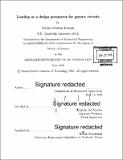| dc.contributor.advisor | Domitilla Del Vecchio. | en_US |
| dc.contributor.author | Kumar, Nithin Senthur | en_US |
| dc.contributor.other | Massachusetts Institute of Technology. Department of Mechanical Engineering. | en_US |
| dc.date.accessioned | 2016-09-13T19:21:16Z | |
| dc.date.available | 2016-09-13T19:21:16Z | |
| dc.date.copyright | 2016 | en_US |
| dc.date.issued | 2016 | en_US |
| dc.identifier.uri | http://hdl.handle.net/1721.1/104284 | |
| dc.description | Thesis: S.M., Massachusetts Institute of Technology, Department of Mechanical Engineering, 2016. | en_US |
| dc.description | Cataloged from PDF version of thesis. | en_US |
| dc.description | Includes bibliographical references (pages 75-78). | en_US |
| dc.description.abstract | Since the 2000s, there have been several forms of synthetic genetic circuits that have been modeled and experimentally validated. Examples include the toggle switch, repressilator, various configurations of oscillators, and even logic gates. A major goal in synthetic biology is to combine these modules to construct complex circuits for applications including biosensing, biofuel technology, and various medical technologies. However, a significant problem when building complex biomolecular circuits is due to context-dependence: the dynamics of a system are altered upon changes to its context, potentially degrading the system's performance. In this thesis, we study retroactivity, a specific type of context-dependence, by analyzing the effects of loads on a transcription factor applied by the transcription factor's target sites. In particular, we study this loading effect on the model of an activator-repressor oscillator, a widely studied motif in systems and systems biology. Our analysis indicates that strong activation and weak repression are key for a stable limit cycle. Repression can be effectively weakened by adding load to the repressor, while activation can be effectively weakened by adding load to the activator. Therefore, loading the repressor can be employed as a design parameter to establish a stable limit cycle. In contrast, loading the activator is deleterious to the clock. Experimental protocol and preliminary data are presented. The results presented in this thesis may be helpful to provide a method to tune the dynamics of synthetic genetic circuits without using tags and modifying promoter regions. | en_US |
| dc.description.statementofresponsibility | by Nithin Senthur Kumar. | en_US |
| dc.format.extent | 78 pages | en_US |
| dc.language.iso | eng | en_US |
| dc.publisher | Massachusetts Institute of Technology | en_US |
| dc.rights | M.I.T. theses are protected by copyright. They may be viewed from this source for any purpose, but reproduction or distribution in any format is prohibited without written permission. See provided URL for inquiries about permission. | en_US |
| dc.rights.uri | http://dspace.mit.edu/handle/1721.1/7582 | en_US |
| dc.subject | Mechanical Engineering. | en_US |
| dc.title | Loading as a design parameter for genetic circuits | en_US |
| dc.type | Thesis | en_US |
| dc.description.degree | S.M. | en_US |
| dc.contributor.department | Massachusetts Institute of Technology. Department of Mechanical Engineering | |
| dc.identifier.oclc | 958162417 | en_US |
